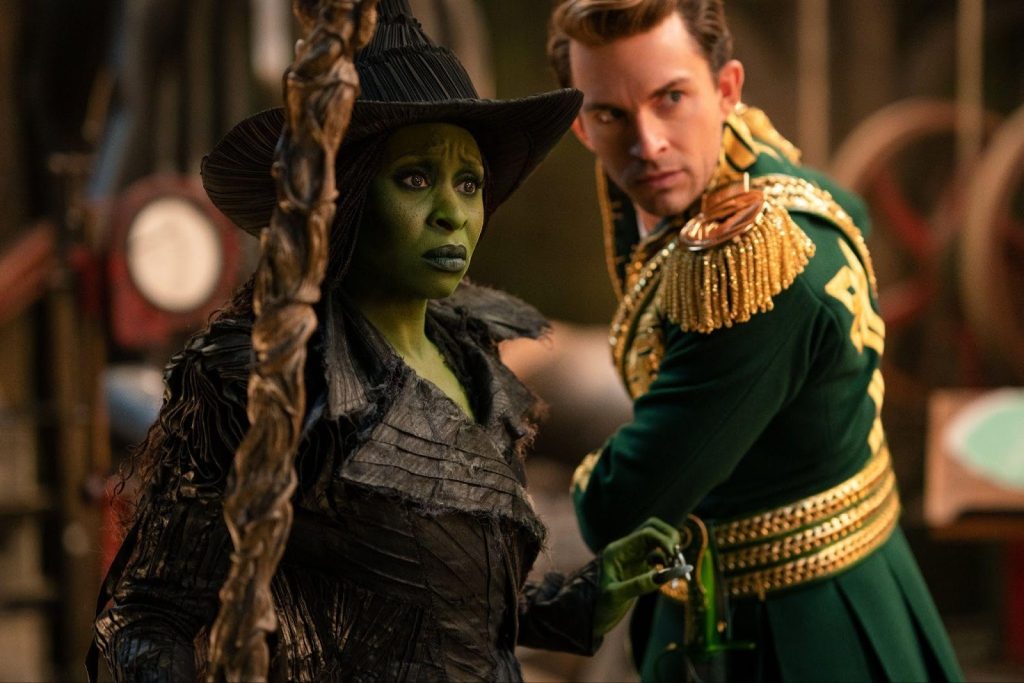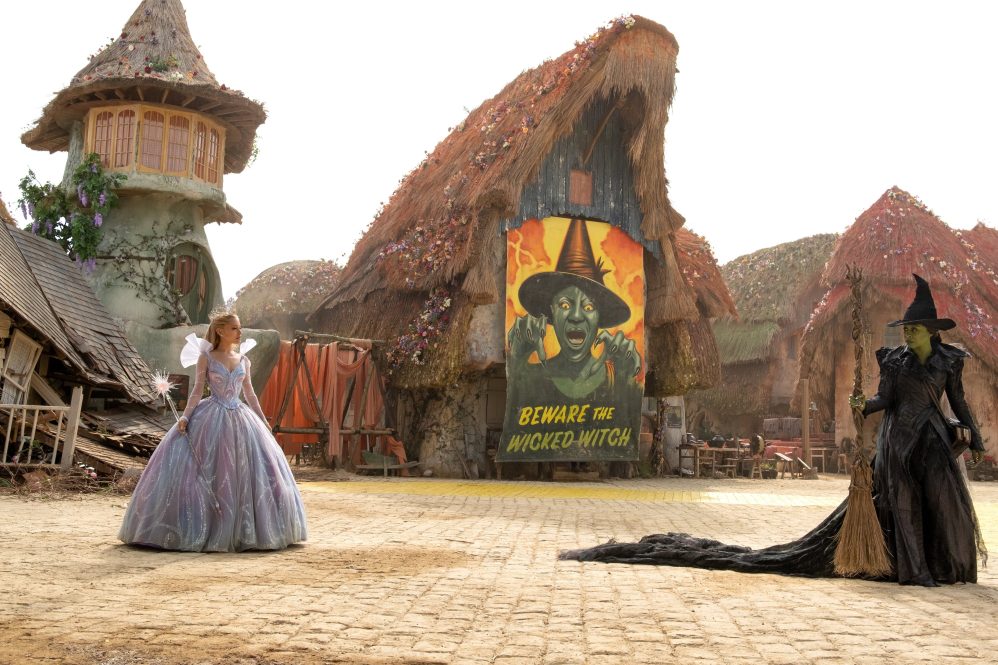
FILM REVIEW
WICKED: FOR GOOD
Rated PG
137 Minutes
Released November 21st
This is a glorious musical epic that defies categorization. Director John M. Chu, cinematographer Alice Brooks, production designer Nathan Crowley, and team have created a world that your eyes will want to swim in. The characters pop out of the screen as unique and fascinating beings who have the same successes and failures, friendships, loves, and animosities as we do, but they are living in a place of vivid imagination.
The filmmakers and cast lived in this world for some five years to make the two-part film, Wicked and Wicked: For Good, spanning interruptions by COVID and the SAG strike. The way the camera moves with the characters and with your imagination when it skims over a landscape, a moment in time, or a room, is brilliant and intuitive, and the colors are rich and meaningful. Fields of bright rainbow-colored tulips are a feast for the eyes, and these flowers are not CGI: the filmmakers paid a British farmer to plant 9 million tulips.

The story is layered, unpredictable, and human. No character is perfect, and their eyes are open to their own flaws. The original 1910 novel from writer L. Frank Baum is woven into the film with finesse. I believe Baum would have loved to see this version of his story, The Wonderful Wizard of Oz, and the Broadway musical that it inspired, especially since Baum had moved to Hollywood in 1910 to write for movies shortly before his death.
Chu, the son of a well-known Northern California chef, won several awards for projects he made when he was a film student at USC, and was discovered when Stephen Spielberg saw one of his short films. In 2025, Chu won the Golden Eagle Eddie Award from the American Cinema Editors USA. Their president, Sabrina Plisco, ACE, said, “from the vibrant energy of In the Heights to the sweeping romance of Crazy Rich Asians, his films are a testament to the power of cinema to transport, entertain, and inspire.” Chu’s Wicked films add to that testament. He believes in preparation, but once he gets to set, it’s “So let’s play!” He wisely pushed to release the epic in two films because “if we were asking people to believe in the stakes, the emotional stakes…of these two women, then we needed time.” Both “Glinda’s” and “Elphaba’s” journeys are skillfully painted with emotional color and passion.

Chu made an excellent decision in hiring Brooks as his cinematographer for the two Wicked films, which were shot together. He had known Brooks since film school, where they both knew that they wanted to make movie musicals. In 2021, Brooks was a cinematographer on the little-seen, beautifully shot Tick, Tick…BOOM! starring Andrew Garfield. She had shot features, TV shows, and commercials and worked with Chu on the musical In the Heights (2021) and two other films. Brooks had worked steadily as a child actress but decided as a teen that she was more drawn to the skills that were needed behind the camera.
Chu and Brooks made a roadmap of the intentions and emotional arc for every scene in the Wicked films, and how they would translate into colors, camera movement, and rhythm. Chu would give Brooks intentions for the camera work, as if she were an actor, and they developed emotional targets for each scene. Brooks also worked very closely each night with editor Myron Kerstein, looking at what was working best. Note that Brooks’ shoot of “the Girl in the Bubble” scene is NOT done with CGI but with light and mirrors.
Brooks notes that most of the visual effects were painstakingly realized and shot. She instinctively knows how to capture dance sequences with exhilarating lyrical movement, an extremely rare skill for camera people who shoot musicals. Every transition from narrative to dance is flawless. Chu says of Brooks, “Alice is not about the tricks and gadgets…she’s about savoring the essence of the frame, the lens, specifically the light. She sees things in a humanistic way. She’s a storyteller, not a technician.”
Writer Winnie Holzman also wrote the Broadway play, Wicked. She and her team have populated the movies with characters who are identifiable, who are passionate, and make us feel love, sadness, and anger. This is a Shakespearean world, with many flawed, wacky inhabitants and some who realize that they are tasked with the heavy responsibility of leadership.
The movie’s sets by production designer Crowley are extraordinarily creative and gorgeous. It’s flawlessly edited by Kerstein, who waded through some 250 hours of footage and beautifully stitched together a mesmerizing quilt of an epic. Kerstein’s style is to “evoke emotion through a single edit.” One scene that he pulled from “the cutting room floor” became a haunting recurring dream of a picnic with “Glinda,” “Elphaba,” “Nessa,” “Fiyero”, and “Boq.”

The voices and dramatic skills of Erivo and Grande are breathtaking. They bring the intense energy of a staged musical to the screen. I knew Erivo was an extraordinary singer when I first saw her in Bad Times at the El Royale (2018). Grande, who has a hugely successful career as a pop singer, undertook extensive vocal training to reach the operatic power and range required for Glinda. Most of the songs were not pre-recorded but sung live while filming. Erivo sings “No Good Deed” while being flung around the set in a harness in a prone position through flames at 18 feet above the floor. Her mic was placed in the peak of her hat. Just listening to the two of them sing here is transformative, and they have a natural chemistry that pervades the story.
Jeff Goldblum steals his scenes as the “Wizard.” He’s not simply an evil tyrant – his face shows that he shocks himself with his own dastardly deeds. Jonathan Bailey proves to be a compassionate, conflicted version of the handsome prince, Fiyero, with just the right dusting of humor. Marissa Bode, as “Nessa,” is a sympathetic character despite her pent-up anger.
The two films were shot simultaneously, with the scenes from the second film providing a sunset feel to the story. This adds a degree of difficulty for the actors to be in the right mindset for each scene. Erivo even wore different perfumes to remind her where she was in Elphaba’s arc. Brooks noted that “It became very clear that the first movie would be effervescent and the second would have a weight and a maturity to it. But there is a visual heartbeat, through lighting and camera, that connects the two.”

Hopefully, this masterpiece will draw some kids to the theatre who prefer to watch 10-minute shorts on YouTube or TikTok. This movie should win a shelf full of Oscars, and you may want to see it more than once. There are things and feelings hidden all around us that, if we stop to look a little harder, we may see. We all need to embrace the light and to see through the darkness. Chu realized that in the end, the title song, “For Good,” sung by Glinda and Elphaba, is about sacrifice and giving strength to each other, an idea that we need to bring forward in our current stressful political climate.
Kathryn Whitney Boole has spent most of her life in the entertainment industry, which has been the backdrop for remarkable adventures with extraordinary people. She is a Talent Manager with Studio Talent Group in Santa Monica. kboole@gmail.com










